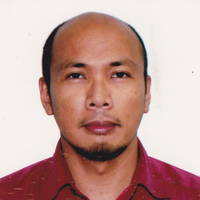Papers by Abraham Maguigad Jr.

This study assessed the emergency management of ten barangays in Tuguegarao City that had the mos... more This study assessed the emergency management of ten barangays in Tuguegarao City that had the most number of affected families by Super Typhoon Lawin. Specifically, this study assessed the level of preparedness of barangays’ contingency plan and early warning system, evacuation management, response/relief system, and responsiveness in the execution of calamity response and after-calamity protocols for the said super typhoon. It likewise assessed the affected families’ level of satisfaction in the implementation of emergency management focused on preparedness and response. The emergency management initiatives that the barangays had, issues and problems encountered, and recommendations for emergency management enhancement were also determined. Descriptive design with the use of triangulation method of research was employed in the study. Interview, survey, documentary analysis and on-site observation were used as data gathering techniques. Descriptive statistics were used in treating the data.
Findings showed that the affected families were ambivalent as to the existence of contingency plan for typhoon and/or flood and early warning system before the super typhoon. Also, they do not know whether or not their barangays were prepared for evacuation management before and during the super typhoon and possess response/relief system after. The affected families were neither satisfied nor dissatisfied in the implementation of activities and services covered by preparedness and response. Common emergency management initiatives among the barangays after the super typhoon were relief distribution, clean-up drive and damage assessment. Generally, the problems encountered by the BDRRMC and affected families were as follows: inadequate equipment and facilities, insufficient funding for disaster preparedness, lack of seminars and trainings pertaining to disaster risk reduction and management, lack of manpower and manpower incompetency. Particularly, affected families encountered unfair and discriminatory distribution of relief goods and other relief assistances.

This study assessed the emergency management of ten barangays in Tuguegarao City that had the mos... more This study assessed the emergency management of ten barangays in Tuguegarao City that had the most number of affected families by Super Typhoon Lawin. Specifically, this study assessed the level of preparedness of barangays' contingency plan and early warning system, evacuation management, response/relief system, and responsiveness in the execution of calamity response and after-calamity protocols for the said super typhoon. It likewise assessed the affected families' level of satisfaction in the implementation of emergency management focused on preparedness and response. The emergency management initiatives that the barangays had, issues and problems encountered, and recommendations for emergency management enhancement were also determined. Descriptive design with the use of triangulation method of research was employed in the study. Interview, survey, documentary analysis and on-site observation were used as data gathering techniques. Descriptive statistics were used in treating the data. Findings showed that the affected families were ambivalent as to the existence of contingency plan for typhoon and/or flood and early warning system before the super typhoon. Also, they do not know whether or not their barangays were prepared for evacuation management before and during the super typhoon and possess response/relief system after. The affected families were neither satisfied nor dissatisfied in the implementation of activities and services covered by preparedness and response. Common emergency management initiatives among the barangays after the super typhoon were relief distribution, clean-up drive and damage assessment. Generally, the problems encountered by the BDRRMC and affected families were as follows: inadequate equipment and facilities, insufficient funding for disaster preparedness, lack of seminars and trainings pertaining to disaster risk reduction and management, lack of manpower and manpower incompetency. Particularly, affected families encountered unfair and discriminatory distribution of relief goods and other relief assistances.
Drafts by Abraham Maguigad Jr.








Uploads
Papers by Abraham Maguigad Jr.
Findings showed that the affected families were ambivalent as to the existence of contingency plan for typhoon and/or flood and early warning system before the super typhoon. Also, they do not know whether or not their barangays were prepared for evacuation management before and during the super typhoon and possess response/relief system after. The affected families were neither satisfied nor dissatisfied in the implementation of activities and services covered by preparedness and response. Common emergency management initiatives among the barangays after the super typhoon were relief distribution, clean-up drive and damage assessment. Generally, the problems encountered by the BDRRMC and affected families were as follows: inadequate equipment and facilities, insufficient funding for disaster preparedness, lack of seminars and trainings pertaining to disaster risk reduction and management, lack of manpower and manpower incompetency. Particularly, affected families encountered unfair and discriminatory distribution of relief goods and other relief assistances.
Drafts by Abraham Maguigad Jr.
Findings showed that the affected families were ambivalent as to the existence of contingency plan for typhoon and/or flood and early warning system before the super typhoon. Also, they do not know whether or not their barangays were prepared for evacuation management before and during the super typhoon and possess response/relief system after. The affected families were neither satisfied nor dissatisfied in the implementation of activities and services covered by preparedness and response. Common emergency management initiatives among the barangays after the super typhoon were relief distribution, clean-up drive and damage assessment. Generally, the problems encountered by the BDRRMC and affected families were as follows: inadequate equipment and facilities, insufficient funding for disaster preparedness, lack of seminars and trainings pertaining to disaster risk reduction and management, lack of manpower and manpower incompetency. Particularly, affected families encountered unfair and discriminatory distribution of relief goods and other relief assistances.